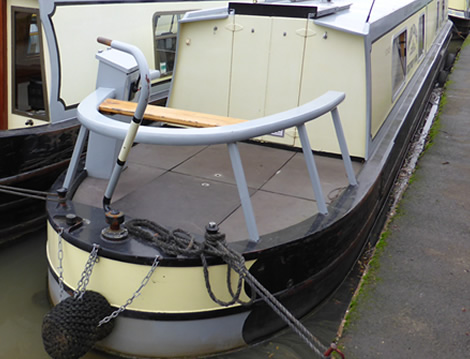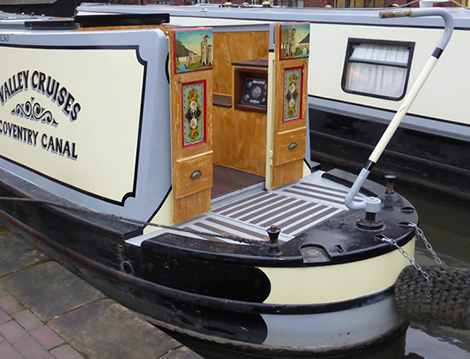Narrowboat types
Many narrowboats are steered using a tiller which is located at the stern of the boat. The steerer stands at the stern of the boat, aft of the hatchway and/or rear doors at the top of the steps up from the cabin. The steering area comes in three basic types, each meeting different needs of maximising internal space; having a more traditional appearance; having a big enough rear deck for everyone to enjoy summer weather or long evenings; or protection outside in bad weather.
Narrow beams are generally 6' 10" wide.
Wide Beam are generally 10' wide and offer more room. Please note: The fuel consumption on these boats will be more than the suggested fuel deposits, due to their size.

Cruiser-stern narrowboats allow people to congregate on deck in good weather and the summer holiday season. The hatch and rear doors are further forward than on a traditional canal boat, creating a large open deck between counter and rear doors, protected by railing (perhaps with built-in seating) around back and sides. At the stern, a "cruiser" narrowboat looks very different from traditional boats. The large rear deck provides a good social space or al-fresco dining area.
The steerer may be unprotected from the elements due to the lack of cover, but this is weighed off against the extra outdoor space, ideal for viewing the surroundings.
A "cruiser" stern allows the engine to be located under the deck, rather than in the body of the boat. Although this may make access to the engine more of a nuisance (due to weather considerations) the whole deck can usually be lifted off in whole or in sections, allowing the operative to stand inside the engine bay, the cruiser stern has a major advantage that the engine is located entirely outside the living space. View the canal boats
A semi-traditional stern is a compromise to gain some of the "social" benefits of a cruiser stern, while retaining a more traditional design and providing some protection for the steerer in bad weather or in cooler seasons. As with the cruiser stern, the deck is extended back from the hatch and rear doors, but in this case most of the deck is protected at the sides by walls which extend back from the cabin sides – giving a more sheltered area for the steerer and companions, usually with lockers to sit on. The engine is located under the deck, much like a cruiser, again allowing a separation between the cabin and the engine bay, with the steps down to the cabin being located past the false sides of the "semi-trad" social area.
View the canal boats
Many modern canal boats retain the traditional layout of a small open, unguarded "counter" or deck behind the rear doors from which the crew can step onto land. It is possible to steer from the counter, but this is not very safe, with the propeller churning below only one missed step away. The "tiller extension" allows the steerer to stand in safety on the top step, forward of the rear doors. In good weather, many trad-stern steerers sit up on the hatchway edge, a high vantage point giving good all-round visibility. On trad boats, the bow "well-deck" forms the main outside viewing area, because the traditional stern is not large enough for anyone other than the steerer to stand on safely.
View the canal boats